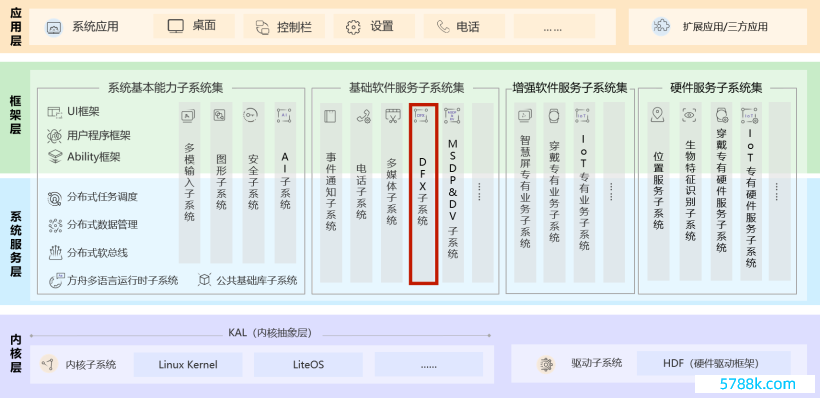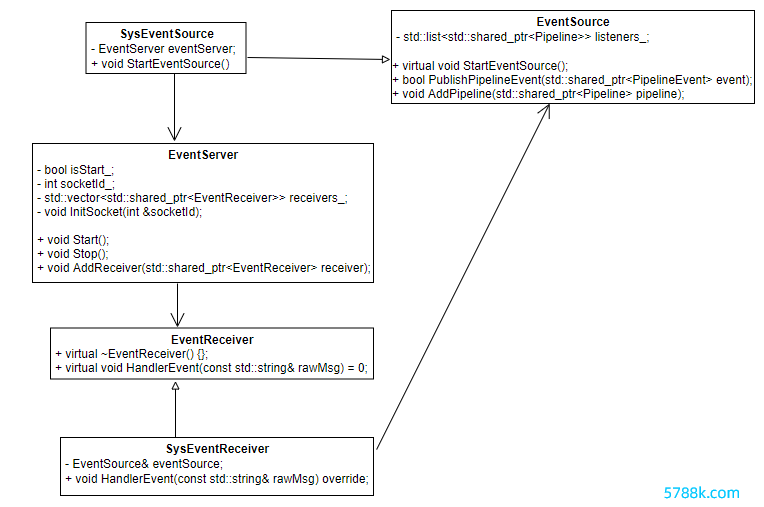新闻资讯
开云(中国)Kaiyun官方网站 OpenHarmony 源码认知之DFX子系统-Hiview(上)
 开云(中国)Kaiyun官方网站
开云(中国)Kaiyun官方网站
念念了解更多内容,请拜访:
51CTO和华为官方调解共建的鸿蒙时候社区
https://harmonyos.51cto.com
1 简介DFX(Design for X)子系统是为了进步软件质地野心的用具集,现在包含的内容主要有:DFR(Design for Reliability,可靠性)和DFT(Design for Testability,可测试性)特质。
已杀青以下功能:
HiLog:活水日记。 HiSysEvent:系统事件纪录接口。 HiView:插件平台。 FaultLoggerd:诈欺故障订阅和集合。 HiAppEvent: js诈欺事件纪录接口。 1.1 OpenHarmony架构图 1.2 Hiview简介
1.2 Hiview简介
Hiview是一个跨平台的终局建立维测处事集。现在开源部分仅包含插件照应平台和系统事件源。
Hiview架构图如下:

Hiview由框架和插件构成,分离为:
操作系统适配层(adapter),对使用的系统处事的接口进行适配。 Hiview基础界说(hiview base),包括插件基类、管说念的界说,事件、事件部队界说以及一些用具类。 Hiview的中枢模块(hiview core),包括插件树立,插件照应以及事件源。 Hiview处事(hiview services),现在仅包括hiview运行信息dump功能。 Hiview插件(plugins),为独建功能的业务模块。 Hiview维测处事是由事件驱动的,其中枢为散播在系统各处的HiSysEvent桩点。形态化的事件通过HiSysEvent API上报至hiview进行处理,如下图:
 诈欺框架、系统处事使用HiSysEvent组件上报系统事件。
Hiview中SysEventSource得到音信,认知并拼装成管说念事件分发给插件处理。
1.3 Hiview代码目次
诈欺框架、系统处事使用HiSysEvent组件上报系统事件。
Hiview中SysEventSource得到音信,认知并拼装成管说念事件分发给插件处理。
1.3 Hiview代码目次
/base/hiviewdfx/hiview. 开云(中国)Kaiyun官方网站├── adapter #平台适配 │ ├── service #处事适配 │ └── system_service #系统接口适配 ├── base #模块界说,用具类 │ └── utility ├── build #编译剧本 ├── core #插件照应中枢代码 ├── include #人人界说 ├── plugins #插件 ├── service #HiviewService处事 └── utility #用具类2 源码分析
本文主要分析hiview插件照应平台的开动化,和事件处理进程。
hiview是个常驻处事,在开机阶段启动。
base/hiviewdfx/hiview/service/config/hiview.cfg界说如下
{ "jobs" : [{ "name" : "post-fs-data", "cmds" : [ "mkdir /data/log/ 0770 system log", "mkdir /data/log/faultlog/ 0770 system system", "mkdir /data/log/faultlog/temp/ 0770 system system", "mkdir /data/log/faultlog/faultlogger/ 0770 system system", "start hiview" ] } ], "services" : [{ "name" : "hiview", "path" : ["/system/bin/hiview"], "uid" : "system", "gid" : ["system", "log"], "writepid" : [ "/dev/cpuset/system-background/tasks" ], "socket" : [ "hisysevent dgram 0666 root system passcred" ] } ] }
2.1 开动化
hiview的进口函数界说在base/hiviewdfx/hiview/main.cpp中
int main(int argc __UNUSED, char* argv[] __UNUSED) { auto& hiview = OHOS::HiviewDFX::HiviewPlatform::GetInstance(); // process cmdline hiview.ProcessArgsRequest(argc, argv); // 开动化环境,主要认知树立文献,加载插件 if (!hiview.InitEnvironment()) { HIVIEW_LOGW("Fail to init plugin environment. exit"); return -1; } // 启动HiviewService处事,该处事提供了hiview运行信息dump功能 auto hiviewService = std::make_unique<OHOS::HiviewDFX::HiviewService>(); hiviewService->StartService(); return 0; }
HiviewPlatform::InitEnvironment()函数杀青如下:
bool HiviewPlatform::InitEnvironment(const std::string& defaultDir, const std::string& cloudUpdateDir, const std::string& workDir, const std::string& persistDir) { // 创建使命目次,现在目次名使用了默许的空字符串,是以并未骨子创建使命目次 ValidateAndCreateDirectories(defaultDir, cloudUpdateDir, workDir, persistDir); // update beta config UpdateBetaConfigIfNeed(); // check whether hiview is already started ExitHiviewIfNeed(); // 认知"/system/etc/hiview/plugin_config"插件树立文献 std::string cfgPath = GetPluginConfigPath(); PluginConfig config(cfgPath); if (!config.StartParse()) { //...........注[1] HIVIEW_LOGE("Fail to parse plugin config. exit!"); return false; } // 启动插件照应平台音信部队 StartPlatformDispatchQueue(); // init global context helper, remove in the future HiviewGlobal::CreateInstance(static_cast<HiviewContext&>(*this)); //加载插件 LoadBusinessPlugin(config); isReady_ = true; NotifyPluginReady(); return true; }
注[1]处PluginConfig::StartParse()函数会按照特定例则去认知插件树立文献:
if (field == "plugins") { ParsePlugin(strTmp); } else if (field == "pipelines") { ParsePipeline(strTmp); } else if (field == "pipelinegroups") { ParsePipelineGroup(strTmp); }
现在使用的插件树立文献/system/etc/hiview/plugin_config内容如下:
plugins:3 SysEventSource[thread:sysevent_source]:0 static Faultlogger[]:0 static SysEventService[thread:sysevent_service]:0 static pipelines:1 SysEventPipeline:SysEventService Faultlogger pipelinegroups:1 SysEventSource:SysEventPipeline
注:base/hiviewdfx/hiview/plugins 下有eventlogger eventservice faultlogger freeze_detector hicollie_collector五个插件目次,而现在插件树立文献里骨子只用到了Faultlogger和SysEventService。
PluginConfig::StartParse()认知完之后会把关系信息保存到列表中。类图如下:

PluginConfig::ParsePipelineGroup()代码如下
void PluginConfig::ParsePipelineGroup(const std::string& pipelineGroup) { std::smatch result; // EventSourceExample:FromTwo2Three FromThree2Two if (!regex_search(pipelineGroup, result, std::regex("(\\S+)\\s*:(.+)"))) { HIVIEW_LOGW("Fail to match pipeline group expression."); return; } const int pipelineGroupNameField = 1; const int pipelineNameListField = 2; std::string eventSourceName = StringUtil::TrimStr(result.str(pipelineGroupNameField)); auto ret = std::find_if(pluginInfoList_.begin(), pluginInfoList_.end(), [&](PluginInfo& info) { if (info.name == eventSourceName) { info.isEventSource = true; info.pipelineNameList = StringUtil::SplitStr(result.str(pipelineNameListField)); return true; } return false; }); if (ret != std::end(pluginInfoList_)) { HIVIEW_LOGD("%s is an event source.", eventSourceName.c_str()); } }
阐扬:
在认知pipelinegroups时,如若发现pipelineGroupName和pluginInfoList中某个插件的name一致,则把该插件PluginInfo.isEventSource置为true况兼把pipelineNameList赋值给PluginInfo.pipelineNameList。 集合/system/etc/hiview/plugin_config树立文献,不错看到SysEventSource插件是带管说念(SysEventPipeline)的,插件SysEventService和Faultlogger附庸于管说念SysEventPipeline,用于处理SysEventSource扔给管说念的事件。认知完插件树立信息之后会调用HiviewPlatform::LoadBusinessPlugin(const PluginConfig& config)去装载插件和管说念。
代码如下
void HiviewPlatform::LoadBusinessPlugin(const PluginConfig& config) { // start to load plugin // 1. 遍历pluginInfoList,字据插件名创建插件。因为现在树立的插件加载延时(loadDelay)为0,是以平直走[2],调用CreatePlugin()创建插件并添加到pluginMap_中。 auto const& pluginInfoList = config.GetPluginInfoList(); for (auto const& pluginInfo : pluginInfoList) { HIVIEW_LOGI("Start to create plugin %{public}s delay:%{public}d", pluginInfo.name.c_str(), pluginInfo.loadDelay); if (pluginInfo.loadDelay > 0) { //.............[1] auto task = std::bind(&HiviewPlatform::ScheduleCreateAndInitPlugin, this, pluginInfo); sharedWorkLoop_->AddTimerEvent(nullptr, nullptr, task, pluginInfo.loadDelay, false); } else { //...............[2] CreatePlugin(pluginInfo); } } // 2. 遍历pipelineInfoList,调用CreatePipeline()创建管说念并添加到pipelines_中。 auto const& pipelineInfoList = config.GetPipelineInfoList(); for (auto const& pipelineInfo : pipelineInfoList) { HIVIEW_LOGI("Start to create pipeline %{public}s", pipelineInfo.name.c_str()); CreatePipeline(pipelineInfo); } // 3. 遍历pluginInfoList,调用InitPlugin()开动化插件 for (auto const& pluginInfo : pluginInfoList) { HIVIEW_LOGI("Start to Load plugin %{public}s", pluginInfo.name.c_str()); InitPlugin(config, pluginInfo); //............注[1] } CleanupUnusedResources(); }
阐扬:
注[1]InitPlugin()这一步中,如若插件的workHandlerType为thread,则绑定使命线程EventLoop。如若插件是EventSource类型,则绑定管说念Pipeline,况兼调用StartEventSource开启音信监听。代码如下:
void HiviewPlatform::InitPlugin(const PluginConfig& config __UNUSED, const PluginConfig::PluginInfo& pluginInfo) { auto& plugin = pluginMap_[pluginInfo.name]; if (plugin == nullptr) { return; } // 如若插件的workHandlerType为thread,则绑定使命线程EventLoop。 if (pluginInfo.workHandlerType == "thread") { auto workLoop = GetAvaliableWorkLoop(pluginInfo.workHandlerName); plugin->BindWorkLoop(workLoop); } auto begin = TimeUtil::GenerateTimestamp(); plugin->OnLoad(); // 如若插件是EventSource类型,则添加管说念Pipeline,况兼调用StartEventSource开启音信监听 if (pluginInfo.isEventSource) { auto sharedSource = std::static_pointer_cast<EventSource>(plugin); if (sharedSource == nullptr) { HIVIEW_LOGE("Fail to cast plugin to event source!"); return; } for (auto& pipelineName : pluginInfo.pipelineNameList) { sharedSource->AddPipeline(pipelines_[pipelineName]); } StartEventSource(sharedSource); } auto end = TimeUtil::GenerateTimestamp(); HIVIEW_LOGI("Plugin %{public}s loadtime:%{public}" PRIu64 ".", pluginInfo.name.c_str(), end - begin); }
至此,插件照应平台开动化使命已完成。
2.2 事件处理进程集合插件树立文献,现在骨子使用的插件类图如下:

阐扬:
前文终末的代码段提到,如若插件是EventSource类型,则绑定管说念,况兼调用StartEventSource开启音信监听。集合类图,只好SysEventSource是EventSource类型的插件,是以只好SysEventSource捏有管说念。 EventSource类型的插件会监听HiSysEvent接口发来的音信,认知并拼装成管说念事件,分发给管说念中的插件处理。SysEventSource::StartEventSource()函数杀青如下。
void SysEventSource::StartEventSource() { HIVIEW_LOGI("SysEventSource start"); std::shared_ptr<EventReceiver> sysEventReceiver = std::make_shared<SysEventReceiver>(*this); eventServer.AddReceiver(sysEventReceiver); eventServer.Start(); }
SysEventSource有个成员变量eventServer,EventServer会开启socketserver端用于接受HiSysEvent接口发来的socket音信。
类图如下:

阐扬:
1.SysEventSource::StartEventSource()中把SysEventReceiver对象加入到EventServer的receivers_容器中。
2.EventServer收到socket音信之后,调用SysEventReceiver::HandlerEvent(const std::string& rawMsg)形态处理接受到的音信。
3.SysEventReceiver::HandlerEvent()形态中会调用SysEventParser::Parser(const std::string& rawMsg)形态认知己信并拼装成SysEvent对象,然后调用EventSource::PublishPipelineEvent(std::shared_ptr
EventSource::PublishPipelineEvent()代码如下:
bool EventSource::PublishPipelineEvent(std::shared_ptr<PipelineEvent> event) { HIVIEW_LOGD("EventSource PublishPipelineEvent"); if (event == nullptr) { return false; } if (Audit::IsEnabled()) { auto digest = GetPluginInfo() + Audit::DOMAIN_DELIMITER + event->GetEventInfo(); Audit::WriteAuditEvent(Audit::StatsEvent::PIPELINE_EVENT_CREATE, event->createTime_, digest); } for (auto& pipeline : listeners_) { if ((pipeline != nullptr) && (pipeline->CanProcessEvent(event))) { // one event can only be processed by one pipeline pipeline->ProcessEvent(event); return true; } } return false; }
集合上头的类图,EventSource捏有管说念列表对象listeners_,EventSource::PublishPipelineEvent()函数中会遍历该列表,调用Pipeline::ProcessEvent(std::shared_ptr
Pipeline类型有个成员变量std::list
在插件平台开动化的时辰,HiviewPlatform::CreatePipeline()函数中也曾把Plugin插件对象加入到了processors_列表中。
接下来分析Pipeline::ProcessEvent()函数作念了什么。
void Pipeline::ProcessEvent(std::shared_ptr<PipelineEvent> event) { event->SetPipelineInfo(name_, processors_); event->OnContinue(); }
把Pipeline的processors_对象赋给了PipelineEvent的processors_对象,然后调用
PipelineEvent::OnContinue()函数。
接下来分析PipelineEvent::OnContinue()函数:
bool PipelineEvent::OnContinue() { // 判断hasFinish_符号位和processors_列表是否也曾为空,如已为空,截至本次事件传递 if ((!hasFinish_) && processors_.empty()) { return OnFinish(); } // once the event start delivering // the call OnContinue means one has done the processing of the event // this may be called by upstream event processor or the framework if (Audit::IsEnabled() && startDeliver_) { Audit::WriteAuditEvent(Audit::StatsEvent::PIPELINE_EVENT_HANDLE_OUT, createTime_, std::to_string(Thread::GetTid())); } // the framework will call OnContinue when the event is assigned to a pipeline if (!startDeliver_) { startDeliver_ = true; } // 取出processors_列表中第一个Plugin元素,并从列表弹出 std::weak_ptr<Plugin> plugin = processors_.front(); processors_.pop_front(); if (auto pluginPtr = plugin.lock()) { if (!pluginPtr->CanProcessMoreEvents()) { handler_->PauseDispatch(plugin); } if (Audit::IsEnabled()) { Audit::WriteAuditEvent(Audit::StatsEvent::PIPELINE_EVENT_HANDLE_IN, createTime_, pluginPtr->GetHandlerInfo()); } // 判断刻下Plugin是否开启了事件使命部队,如有则加入事件部队处理,如莫得平直调用OnEventProxy if (auto workLoop = pluginPtr->GetWorkLoop()) { workLoop->AddEvent(pluginPtr, shared_from_this()); //............[1] } else { pluginPtr->OnEventProxy(shared_from_this()); //..........[2] } } else { return OnContinue(); } return true; }
不论插件是否使用了事件部队,最终皆会调用到Plugin::OnEventProxy()函数来处理管说念事件。
Plugin::OnEventProxy()函数杀青如下:
bool Plugin::OnEventProxy(std::shared_ptr<Event> event) { if (event == nullptr) { return false; } std::shared_ptr<Event> dupEvent = event; auto processorSize = dupEvent->GetPendingProcessorSize(); dupEvent->ResetPendingStatus(); bool ret = OnEvent(dupEvent); //..............注[1] if (!dupEvent->IsPipelineEvent()) { if (Audit::IsEnabled()) { Audit::WriteAuditEvent(Audit::StatsEvent::QUEUE_EVENT_OUT, dupEvent->createTime_, std::to_string(Thread::GetTid())); } } else { if ((!dupEvent->HasFinish() && !dupEvent->HasPending()) && (processorSize == dupEvent->GetPendingProcessorSize())) { dupEvent->OnContinue();//.............注[2] } } return ret; }
先调用注[1]OnEvent()函数处理事件,再判断管说念事件传递是否已截至,如未截至则调用注[2]PipelineEvent::OnContinue()函数陆续把管说念事件传递给背面的
插件处理。
集合现在的插件树立文献,所有这个词这个词插件照应平台的音信处理进程约莫如下:
EventServer接受到HiSysEvent组件接口发来的音信 --> SysEventReceiver::HandlerEvent() --> SysEventParser::Parser() --> EventSource::PublishPipelineEvent() --> Pipeline::ProcessEvent() --> PipelineEvent::OnContinue() --> SysEventService::OnEventProxy --> SysEventService::OnEvent --> PipelineEvent::OnContinue() --> Faultlogger::OnEventProxy --> Faultlogger::OnEvent --> 截至
至此,事件处理进程已分析完。
3 记忆以上内容领先分析了hiview插件照应平台的开动化,然后对事件的处理进程作念了分析。后续会详备栽种base/hiviewdfx/hiview/plugins目次下每个插件的源码。
念念了解更多内容,请拜访:
51CTO和华为官方调解共建的鸿蒙时候社区
https://harmonyos.51cto.com

